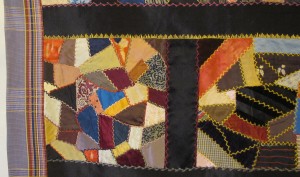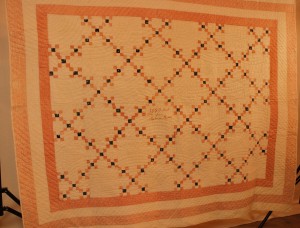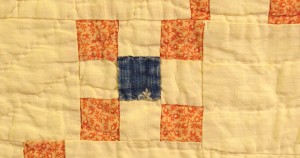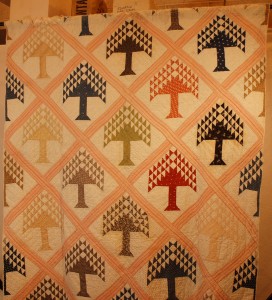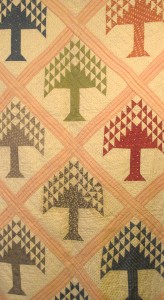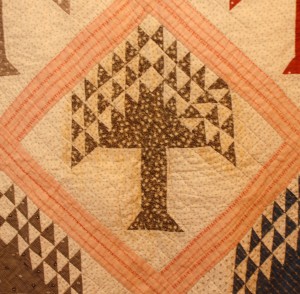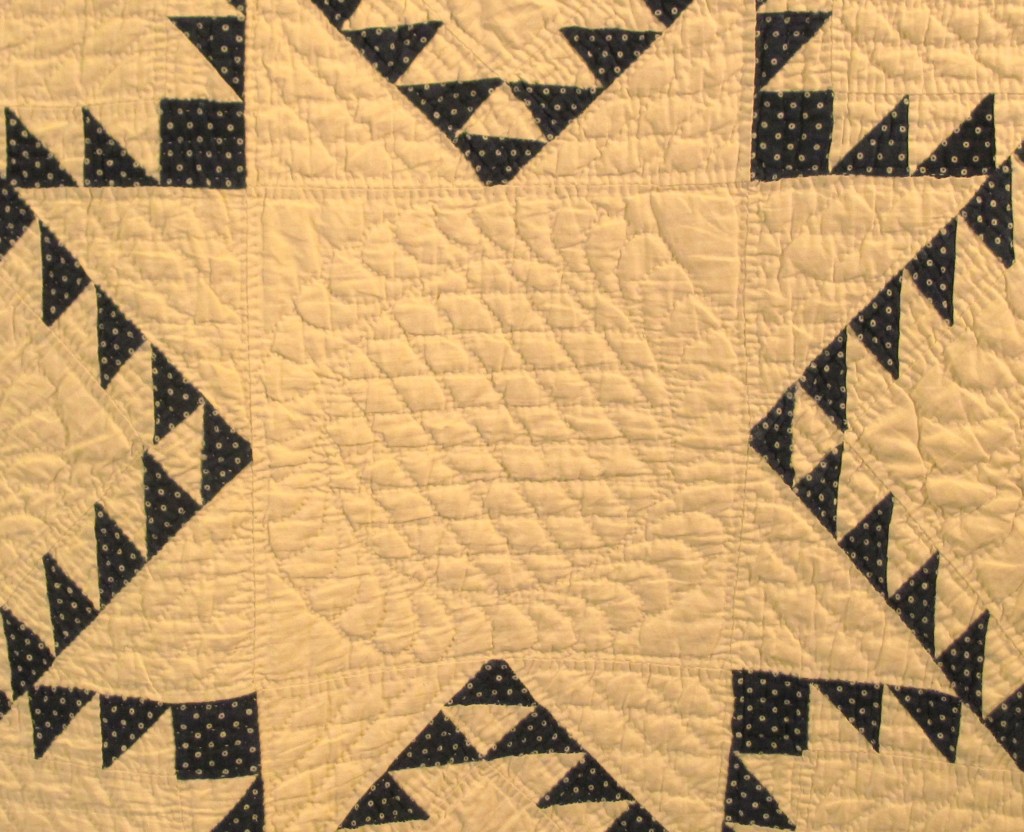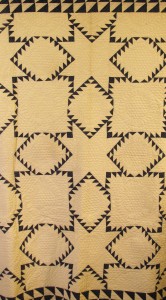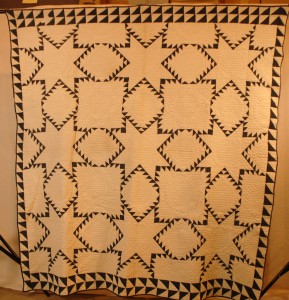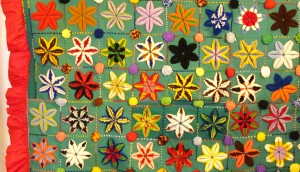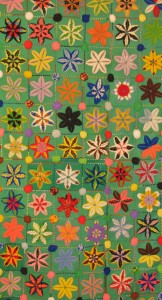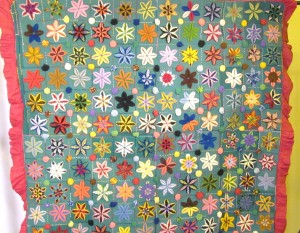The Crazy Quilt
Crazy Quilts are assembled using irregular and random pieces of fabric, without pattern, on a foundation fabric or paper. The patches and seams are generally heavily embellished. Crazy Quilts often are made from exotic pieces of fabric such as velvet, satin, tulle, or silk and embellished with buttons, lace, ribbons, beads or embroidery (10). This method of quilting is one of the most unique as every patch is different, and is a textile art, which is extremely creative and free flowing.

Detail of a crazy quilt made by Mrs. Louis Dibble circa 1883, most likely in Corrina, Utah. Idaho Historical Society (1971.119.1)
The popularity of the Crazy Quilt began in the 1876 at the Philadelphia Centennial Exposition. The Crazy Quilt was one of the most popular exhibits. “Women were eager to incorporate this new look into their quilts, and with the help of popular women’s magazines, the making of Crazy Quilts became quite the rage (11). Enthusiasm for this quilting fad continued until about 1910, although it is still a common quilting method.
Nine Patch Quilt
The basic form of a Nine Patch Quilt consists of nine equal squares, arranged three rows across and three down. Early block designs allowed frugal quilters to use very small scraps of fabric and were often made from pieces of cloth left over from making clothing or cut from old worn-out clothes. Thus, these quilts were made in a myriad of colors and not just basic colors such as brown, as many people have thought (12). The Nine Patch Quilt was often used for utilitarian purposes. Consequently, many of the preserved quilts are worn from use.
The first known and dated Nine Patch Quilts were made at the beginning of the nineteenth century and they are still a popular form of quilt making today. Because of its simplicity and ease of maneuvering when making, many quilters learned their craft by making the Nine Patch Quilt, “Early American quilters typically made their quilts by adding small pieces of fabric or strips to an ever-growing top. This proved to be cumbersome and difficult to work with as the quilt top approached its full size. Therefore, quilters gradually began breaking their projects into more manageable blocks” (13).
Between 1800-1840, because patchwork blocks were both portable and a frugal way to use scraps, they became popular among pioneer women. By 1837, as on our own Nine Patch Quilt, stenciled names and dates began appearing on quilts. By the 1850’s patchwork quilts were considered a lower class pastime to keep youngsters entertained (14).
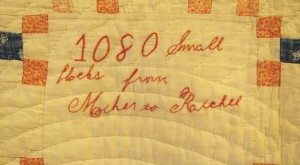
Nine Patch Quilt. Given to donor by Martha Hull, of the Hull's Gulch family in Boise, Idaho. The center embroidered script reads: "1080 small blocks from Mother to Rachel". Rachel was Martha's mother. The quilt dates to c. 1820
Tree Of Life Quilts
What most people would perceive as a “Tree of Life” quilt was popular just before and after 1800. These quilts often had a tree in the center. “The designs were cut out from Indian palampores or bedcovers and were often enhanced and elaborated with additional birds, animals, and other chintz cutouts” (15). The hill where the tree sat was called a “terra firma” mound and “represented an idealized version of the world abounding the flora and fauna” (16). As the nineteenth century progressed, the Tree of Life of pattern progressed into the current triangle pattern and became more popular throughout the century (17). “The Tree of Life continues to be a popular motif for quilters, sometimes appearing as a center for medallion quilts and sometimes used as a family tree” (18). Broderie perse is used to describe “delicate cutout designs of print fabric, usually chintz, applied to a solid foundation with fine embroidery stitches” (19). The pieced block design was very popular in the United States and during the 1840’s and 1860’s the tree motifs were in fashionable use, as well as the use of diamonds and triangles in the design (20). These have also been known as the Live Oak Tree, Forbidden Fruit Tree, and Temperance Tree (21). According to Jenkins and Seward: it was popular design that was translated into a pine tree design and the pine tree came to represent, for many pioneers, a remembrance of life back home” (22).
Example of a Tree of Life Quilt.
This Tree of Life Quilt belonged to Ellen Sears Potter, who first came to Idaho in 1915 from the Midwest. This quilt was made circa 1890.
The Indigo and Blue Quilt
Unlike the other quilts in this exhibition, the Indigo and Blue quilt does not necessarily fit one particular pattern, but several different ones.
- Idaho State Historical Society (2001.75.0)
Aspects of the Irish Chain can be found in this quilt, and there are shapes such as: diamonds, stars, rectangles, and triangles incorporated into the quilt. The quilt was done in the Mennonite style, these quilts traditionally incorporated bright colors with prints in the design (23).
Star Quilt
As the Industrial Revolution began to lessen the need for hand-sewn items middle- and upper-class women often made quilts, such as the Star Quilt seen below, for purely artistic purposes, to be displayed rather than used.
These quilts are often the ones that have survived through the years since quilts made by poorer women were thoroughly used and worn out(24).
Middle-and upper-class women were both expected to revel in staying h0me and doing traditionally feminine activities while their husbands went out to work, and they might have been able to take their time with quilting, making their quilts prettier and more intricate than those made by working-class women who were using their quilts solely for utilitarian purposes (25).
Wedding Quilts
Of the world’s earliest surviving quilts 2 are wedding quilts (26). A couple’s wedding quilt was an irreplaceable part of their new household filled with the most complicated stitching a seamstress knew how to make and symbols meant to bring luck, wealth, fertility, and happiness to the marriage (27). Many times there was a central piece stitched into the quilt, such as a bouquet of flowers or a cornucopia with fruit spilling from it and the special symbols surrounding it (28).
A woman’s friends and family often helped her work on her wedding quilt, sometimes for years (29). These quilts were often called album quilts because kin and friends of the couple would sign blocks on the quilt, sometimes with ink and sometimes actually stitching a special mark associated with one seamstress (30). The signatures closest to the central piece were the closest family members and the names further away were friends of the couple but perhaps not as close (31).
Wedding quilts can use patches of different fabrics to make the design of the quilt or they can be whole cloth quilts. Whole cloth quilts use only one large piece of fabric (32). In order to get a design on the quilt they use very intricate stitching, showing off the seamstress’s prowess with a needle. These quilts are often white or a very light colored fabric and not only did the quilts include intricate geometric patterns but they often had difficult floral patterns as well.
(1) Susan Jenkins and Linda Seward, The American Quilt Story: The How-To and Heritage of a Craft Tradition (Pennsylvania: Rodale Press, 1991), 23.
(2) Ibid.
(3)Carter Houck, The Quilt Encyclopedia Illustrated (New York: Harry N. Abrams, Inc., 1991), 126.
(4) Ibid., 137.
(5) Pat Ferrero, Hearts and Hands: The Influence of Women and Quilts on American Society (San Francisco: The Quilt Digest Press, 1987), 16.
(6)Ibid., 51.
(7)Ibid., 57.
(8)Ibid., 61.
(9)Ibid., 15.
(10) Betty Pillsbury and Rita Vainius, “The History of Crazy Quilts, Part I”, The Caron Collection, Created: 1997, Accessed: March 16, 2012, http://www.caron-net.com/featurefiles/featmay.html.
(11) Judy Anne Breneman, “Crazy Quilt History: A Victorian Craze”, Womenfolk.com, Created: 2001, Accessed: March 16, 2012, http://www.womenfolk.com/quilting_history/crazy.htm.
(12) Judy Anne Breneman, “Nine Patch Quilt Patterns for Babies and Dolls,” Womenfolk.com, Created: 2005, Accessed March 16, 2012, http://www.womenfolk.com/baby_quilts/ninepatchchild.htm.
(13)Lisa Allen, “Quilt Blocks Piece by Piece,” Quilting in America, Created 2009, Accessed: March 16, 2012, http://www.quilting-in-america.com/Quilt-Blocks.html.
(14) A Timeline of Quilting History in America,” Reddawn.net, Created: 2010, Accessed: March 16, 2012, http://www.reddawn.net/quilt/timeline.htm.
(15)Carter Houck, The Quilt Encyclopedia Illustrated (New York: Harry N. Abrams, Inc., 1991), 174.
(16) Ibid.
(17) Ibid.
(18) Ibid., 175.
(19) Ibid., 34.
(20) Ibid., 172.
(21) Ibid.
(22) Susan Jenkins and Linda Seward, The American Quilt Story: The How-To and Heritage of a Craft Tradition (Pennsylvania: Rodale Press, 1991), 218.
(23) Carter Houck, The Quilt Encyclopedia Illustrated (New York: Harry N. Abrams, Inc., 1991), 104.
(24)Pat Ferrero, Hearts and Hands: The Influence of Women and Quilts on American Society (San Francisco: The Quilt Digest Press, 1987), 14.
(25)Ibid., 25.
(26) Lady Sarah Davies, Quilt History (http://www.quilthistory.com/quilting.htm, n.d.).
(27) Roderick Kiracofe, The American Quilt (New York: Clarkson N. Potter, Inc., 1993), 63-66.
(28) Anne Breneman, America’s Quilting History: Quilting From Colonial Times Through the 20th century (http://www.quilthistory.com/quilting.htm, 1998).
(29) Ruth E. Finley, Old Patchwork Quilts and the Women who Made Them (McLean, VA: EPM Publications, Inc., 1929), 30-31.
(30) Anne Breneman, America’s Quilting History: Quilting From Colonial Times Through the 20th century (http://www.quilthistory.com/quilting.htm, 1998).
(31) Ibid.
(32) Charlotte Robinson, The Artist and the Quilt (New York: Alfred A. Knopf, Inc., 1983), 25.
